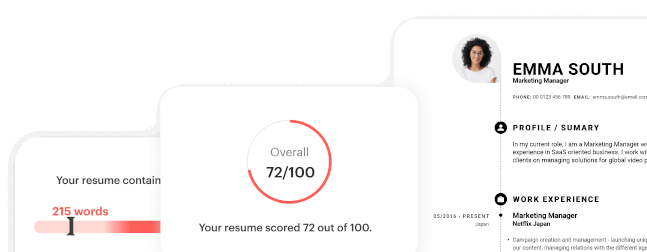Are you ready to embark on an exciting journey to optimize your science career? Look no further, because this guide will equip you with the essential tools to create a remarkable science cover letter that's sure to captivate employers.
Earning a position in your scientific discipline requires an optimized cover letter that showcases your most relevant professional strengths.
From showcasing your expertise in molecular magic to highlighting your stellar research accomplishments, we'll explore the key elements that will launch your cover letter to new heights.
Continue reading to learn more about:
- Formatting your science cover letter header and headline
- Making your science cover letter personalized to specific employers
- Writing an effective introduction for your science cover letter
- Highlighting your professional strengths as a scientist
- Concluding your science cover letter with a well-written closing statement
- Finding useful job search resources for scientists
1. Format your science cover letter header and headline properly
The beginning of any great science cover letter starts with an excellently formatted header and headline.
A cover letter header always comes first, placed at the top of the page. This header should contain key pieces of information about both you and the employer, such as:
- Your name and professional title
- Your professional contact information
- The name of the employer and/or company
- The department of the company you are applying to (when applicable)
- The address of the company
Here is an example of a well-formatted science cover letter header
John Doe, Biology Scientist
(123) 456-7890 | johndoe@email.com | linkedin.com/in/john-doe
To: General Labs & Development, Inc.
Biology Science Department
1234 Street Address
Washington, D.C. 2001
Following your header is a cover letter headline. Think of this as a title to your cover letter that highlights key points and helps to captivate the employer’s attention.
Your headline should be one sentence or line of text and include compelling details that are highly relevant to both the position you are applying to and the content of your cover letter.
Here is an example of a well-written science cover letter headline
My 3-Step Approach to Conducting Scientific Research & How This Approach Can Benefit Your Lab
2. Make your science cover letter personalized to specific employers
Writing cover letters is a fairly commonplace practice, with most employers expecting to receive a cover letter when job applications are submitted for open positions.
What many applicants don’t realize, however, is that a core requirement of a successful cover letter is personalization. Personalization refers to a process of tailoring a cover letter to be highly specific to each individual employer, addressing their specific wants and needs.
To personalize a cover letter, it is crucial to research the employer thoroughly ahead of time to find out essential details, such as the company’s values and goals.
Additionally, you should always include a personalized greeting on your cover letter that addresses a specific person by name, such as the company CEO or a hiring manager.
Here are 3 examples of personalized science cover letter greetings
- Dear Lab Supervisor Jack Green,
- Dear Mr. Jack Green,
- Dear Hiring Manager Joe Johnson,
3. Write an effective introduction for your science cover letter
The next necessity for your science cover letter is an effective and compelling introduction.
Introductory paragraphs should be concise, typically between two to three sentences in total. In this introduction, you want to provide the employer with a clear explanation of why you are a qualified candidate that should be considered for the job.
Here is an example of an effective science cover letter introduction
Dear Lab Supervisor Jack Green,
I am a recent graduate of Columbia University with a Master of Science in Clinical Research Methods. In my time as a student at Columbia, I worked for 3 years as a lab assistant and 1 year as a lab teaching assistant. My experience in the university labs has given me the technical prowess and interpersonal competence to effectively fulfill the role of assistant lab supervisor at your company.
4. Highlight your professional strengths as a scientist
In a resume, you spend a lot of your writing space delving into the specifics of your educational and work experience. Comparatively, in a cover letter, you should spend more time explaining your top achievements and relevant skills, highlighting these qualifications as your professional strengths.
As you describe your key skills and achievements, make sure to include details that are highly relevant to the position and include contextual information. Your primary goal is to show the employer the real-life value you bring to the table that gives you an edge over other applicants.
Here are 6 skills to describe in a science cover letter
- Examining and analyzing lab samples
- Documenting and writing reports on lab results
- Developing hypotheses that can be tested
- Communicating and collaborating with other scientists
- Specific scientific specializations (biology, botany, etc.)
- Deep knowledge of utilizing scientific equipment
Here are a few examples of how to describe achievements in a science cover letter
- As a Lab Scientist at [Former Employer], I worked as a lab assistant helping to supervise experiments carried out by undergraduate students. In this role, I play a key role as a student mentor, helping to implement safer laboratory practices that resulted in a 15% decrease in dangerous lab incidents. Additionally, I led a research experiment that resulted in the development of a new scientific patent for the university.
- I take pride in spearheading a groundbreaking research project that resulted in the discovery of a new cancer biomarker. This achievement not only expanded our understanding of cancer diagnostics but also holds great potential for personalized treatments. Leading a team of talented scientists, I successfully designed and executed experiments, collected and analyzed data, and collaborated with renowned oncologists to validate our findings. Our breakthrough publication in a prestigious scientific journal garnered significant recognition within the scientific community and has the potential to make a significant impact in the field of oncology.
- During my tenure as a research scientist, I developed and optimized a novel laboratory technique that increased the efficiency of gene editing by 60%. By implementing streamlined protocols and leveraging cutting-edge CRISPR technology, I successfully edited over 500 target genes across multiple cell lines. This breakthrough not only saved valuable research time but also positioned our team as pioneers in the field of gene editing. Additionally, I presented our findings at two international conferences, reaching an audience of over 500 scientists, and received the 'Innovation in Research' award from my institution in recognition of this achievement.
5. Conclude your science cover letter with a well-written closing statement
Anytime you write a science cover letter, you should always end with a strong conclusion that reiterates your excitement for the position and encourages the employer to get in touch with you.
In your conclusion, make sure to include:
- An enthusiastic sentence saying you are looking forward to hearing from them
- Key information on how to best get in contact with you, as well as the best days and times for contacting you are
- A formal sign-off
Here is an example of a strong conclusion from a science cover letter
As your company is one of the top scientific research centers in D.C., it brings me great excitement and gratitude to be considered for this position. I look forward to speaking with you more about this opportunity and am available to meet on Monday through Friday between the hours of 9 a.m. to 6 p.m. To best reach me, please call me at (123) 456-7890.
With Sincerity,
[Applicant Name]
If you have ever wondered how a cover letter differs from a resume, this article will tell you everything about the key differences between the two.

6. Useful job search resources for scientists
As a scientist looking to navigate the job market, a variety of resources specifically tailored to your field can offer great advantages. Let's explore some of these key resources:
- Job-search websites for scientists: Websites like Nature Jobs, Science Careers, and New Scientist Jobs are platforms curated for science jobs across all disciplines. These sites offer job listings, career advice articles, and employer information.
- Professional networks: Join professional organizations or associations in your field. The American Association for the Advancement of Science (AAAS) or the National Postdoctoral Association, for example, offer networking opportunities and job boards.
- LinkedIn: Around 90% of recruiters use LinkedIn as a tool to find eligible candidates. Do not underestimate the power of a strong and well-maintained LinkedIn profile. Join relevant groups, follow industry leaders, and engage in professional discussions.
- Company websites: Directly check the career pages of companies you are interested in. Most companies post job vacancies and internships on their websites.
- Mentors: Tap into your existing network of professors, colleagues, alumni. Their advice and contacts in the industry can be extremely useful.
- Online skill enhancement: Websites like Coursera or Khan Academy offer many courses taught by industry experts that can advance your skills and knowledge, making your application more attractive to employers.
- Scientific journals: Subscriptions to journals such as Science and Nature allow you to stay tuned with the latest advancements in your field, making you a better-rounded candidate.
Remember, every successful job search starts with a clear strategy and the right mix of resources at your disposal. Happy hunting!
Science Cover Letter FAQ
Yes, for a science cover letter, highlight any experience you have with essential lab techniques or procedures, your familiarity with industry-standard scientific tools and software, important scientific projects you've undertaken, and key findings or results.
Absolutely. If you've been part of published research, this can notably enhance your credentials. Briefly mention your involvement and the impact of the research. If space allows, you can also provide a link to the publication.
Show genuine passion for the field you're applying in and try to showcase that you're on top of the latest developments in this area. Also, make sure that you demonstrate a deep understanding of the organization's work and how you can contribute to it.
Highlight your academic achievements, particularly those relevant to the job. Discuss your thesis or significant projects you've completed during your course. If you've done internships or relevant volunteer work, make sure to include those experiences as well.
Yes, it's essential to tailor your cover letter to each job and company. This shows the employer that you have a genuine interest in the role and that you've taken the time to understand their specific requirements.























